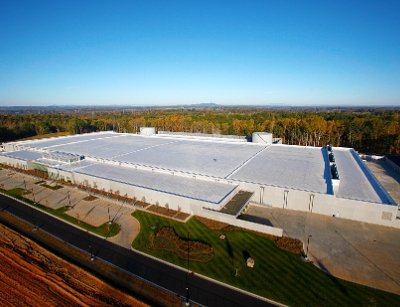Apple’s widely reported on solar array project in Maiden, North Carolina, alongside its new data center there, will generate 20MW at peak capacity. That can power many of the larger data centers around the world, but only a portion of the company’s massive Maiden facility.
James Hamilton, of Amazon Web Services, questions the real value of the solar array, taking in consideration its capacity in comparison to the data center’s roughly estimated total capacity and the sheer amount of land Apple had to clear to accommodate the array.
“I’m personally not crazy about clearing 171 acres in order to supply only 4% of the power at this facility,” Hamilton wrote in a recent blog post. “There are many ways to radically reduce aggregate data center environmental impact without as much land consumption.”
He says if he was looking at reducing the facility’s impact, he would look into increasing efficiency of the power and cooling infrastructure, as well as IT infrastructure, including networking and storage. He would also look at increasing utilization of all of these assets.
The building itself is already highly efficient. The US Green Building Council has given it LEED Platinum certification – the highest tier of the council’s rating system for environmentally friendly buildings.
The company is also building a large fuel cell installation at the site. The biogas-powered 5MW facility is expected to come online later in 2012, according to the company’s Facilities 2012 report.
Apple has kept quiet about the total power consumption of the Maiden data center, so Hamilton made a rough estimate based on the information available. This is a 500,000 sq ft facility, which by a conservative estimate can consume a total of about 78MW of power total at a moderate Power Usage Effectiveness (PUE), Hamilton concluded, adding that “the actual number is likely somewhat higher.”
In addition to the array’s relatively insignificant impact on the data center’s impact on the environment, there is a hidden cost to US taxpayers, he pointed out. The panels are manufactured by SunPower, a company that received a US$1.2bn loan guarantee from the federal government and is $820m in debt.
Hamilton is skeptical about SunPower in light of a recent failure of Solyndra – another solar-cell company that was backed by the government – which filed for bankruptcy in September.
In the same blog post, he talks about Facebook’s much smaller solar array that contributes power to the company’s data center site in Prineville, Oregon. According to his estimates, the array is only powerful enough to power one rack in the data center. Its total capacity is 100kW, but if local weather and elevation are taken into consideration, it only produces about 13.75kW on average, Hamilton reasons.

